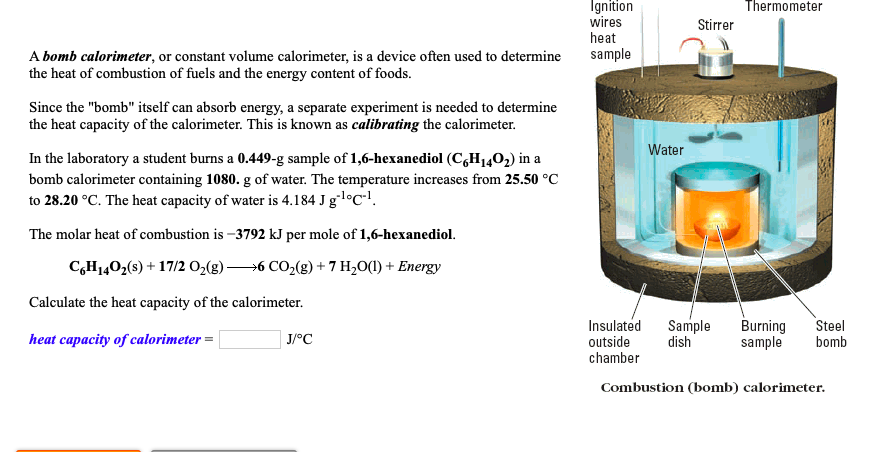heat sample A bomb calorimeter, or constant volume calorimeter, is a device often used to determine the heat of combustion of fuels and the energy content of foods. Since the "bomb" itself can absorb energy, a separate experiment is needed to determine the heat capacity of the calorimeter. This is known as calibrating the calorimeter. Water In the laboratory a student burns a 0.449-g sample of 1,6-hexanediol (C,H1402) in a bomb calorimeter containing 1080. g of water. The temperature increases from 25.50 °C to 28.20 °C. The heat capacity of water is 4.184 J glºC"!. The molar heat of combustion is –3792 kJ per mole of 1,6-hexanediol. C,H1402(s) + 17/2 02(g) 6 CO2(g) + 7 H20(1) + Energy Calculate the heat capacity of the calorimeter.
heat sample A bomb calorimeter, or constant volume calorimeter, is a device often used to determine the heat of combustion of fuels and the energy content of foods. Since the "bomb" itself can absorb energy, a separate experiment is needed to determine the heat capacity of the calorimeter. This is known as calibrating the calorimeter. Water In the laboratory a student burns a 0.449-g sample of 1,6-hexanediol (C,H1402) in a bomb calorimeter containing 1080. g of water. The temperature increases from 25.50 °C to 28.20 °C. The heat capacity of water is 4.184 J glºC"!. The molar heat of combustion is –3792 kJ per mole of 1,6-hexanediol. C,H1402(s) + 17/2 02(g) 6 CO2(g) + 7 H20(1) + Energy Calculate the heat capacity of the calorimeter.
Chemistry by OpenStax (2015-05-04)
1st Edition
ISBN:9781938168390
Author:Klaus Theopold, Richard H Langley, Paul Flowers, William R. Robinson, Mark Blaser
Publisher:Klaus Theopold, Richard H Langley, Paul Flowers, William R. Robinson, Mark Blaser
Chapter5: Thermochemistry
Section: Chapter Questions
Problem 51E: A sample of 0.562 g of carbon is burned in oxygen in a bomb calorimeter, producing carbon dioxide....
Related questions
Question

Transcribed Image Text:heat
sample
A bomb calorimeter, or constant volume calorimeter, is a device often used to determine
the heat of combustion of fuels and the energy content of foods.
Since the "bomb" itself can absorb energy, a separate experiment is needed to determine
the heat capacity of the calorimeter. This is known as calibrating the calorimeter.
Water
In the laboratory a student burns a 0.449-g sample of 1,6-hexanediol (C,H1402) in a
bomb calorimeter containing 1080. g of water. The temperature increases from 25.50 °C
to 28.20 °C. The heat capacity of water is 4.184 J glºC"!.
The molar heat of combustion is –3792 kJ per mole of 1,6-hexanediol.
C,H1402(s) + 17/2 02(g) 6 CO2(g) + 7 H20(1) + Energy
Calculate the heat capacity of the calorimeter.
Expert Solution
This question has been solved!
Explore an expertly crafted, step-by-step solution for a thorough understanding of key concepts.
This is a popular solution!
Trending now
This is a popular solution!
Step by step
Solved in 4 steps with 3 images

Knowledge Booster
Learn more about
Need a deep-dive on the concept behind this application? Look no further. Learn more about this topic, chemistry and related others by exploring similar questions and additional content below.Recommended textbooks for you

Chemistry by OpenStax (2015-05-04)
Chemistry
ISBN:
9781938168390
Author:
Klaus Theopold, Richard H Langley, Paul Flowers, William R. Robinson, Mark Blaser
Publisher:
OpenStax

Chemistry
Chemistry
ISBN:
9781305957404
Author:
Steven S. Zumdahl, Susan A. Zumdahl, Donald J. DeCoste
Publisher:
Cengage Learning


Chemistry by OpenStax (2015-05-04)
Chemistry
ISBN:
9781938168390
Author:
Klaus Theopold, Richard H Langley, Paul Flowers, William R. Robinson, Mark Blaser
Publisher:
OpenStax

Chemistry
Chemistry
ISBN:
9781305957404
Author:
Steven S. Zumdahl, Susan A. Zumdahl, Donald J. DeCoste
Publisher:
Cengage Learning


Chemistry: An Atoms First Approach
Chemistry
ISBN:
9781305079243
Author:
Steven S. Zumdahl, Susan A. Zumdahl
Publisher:
Cengage Learning

Principles of Modern Chemistry
Chemistry
ISBN:
9781305079113
Author:
David W. Oxtoby, H. Pat Gillis, Laurie J. Butler
Publisher:
Cengage Learning

Chemistry for Engineering Students
Chemistry
ISBN:
9781337398909
Author:
Lawrence S. Brown, Tom Holme
Publisher:
Cengage Learning